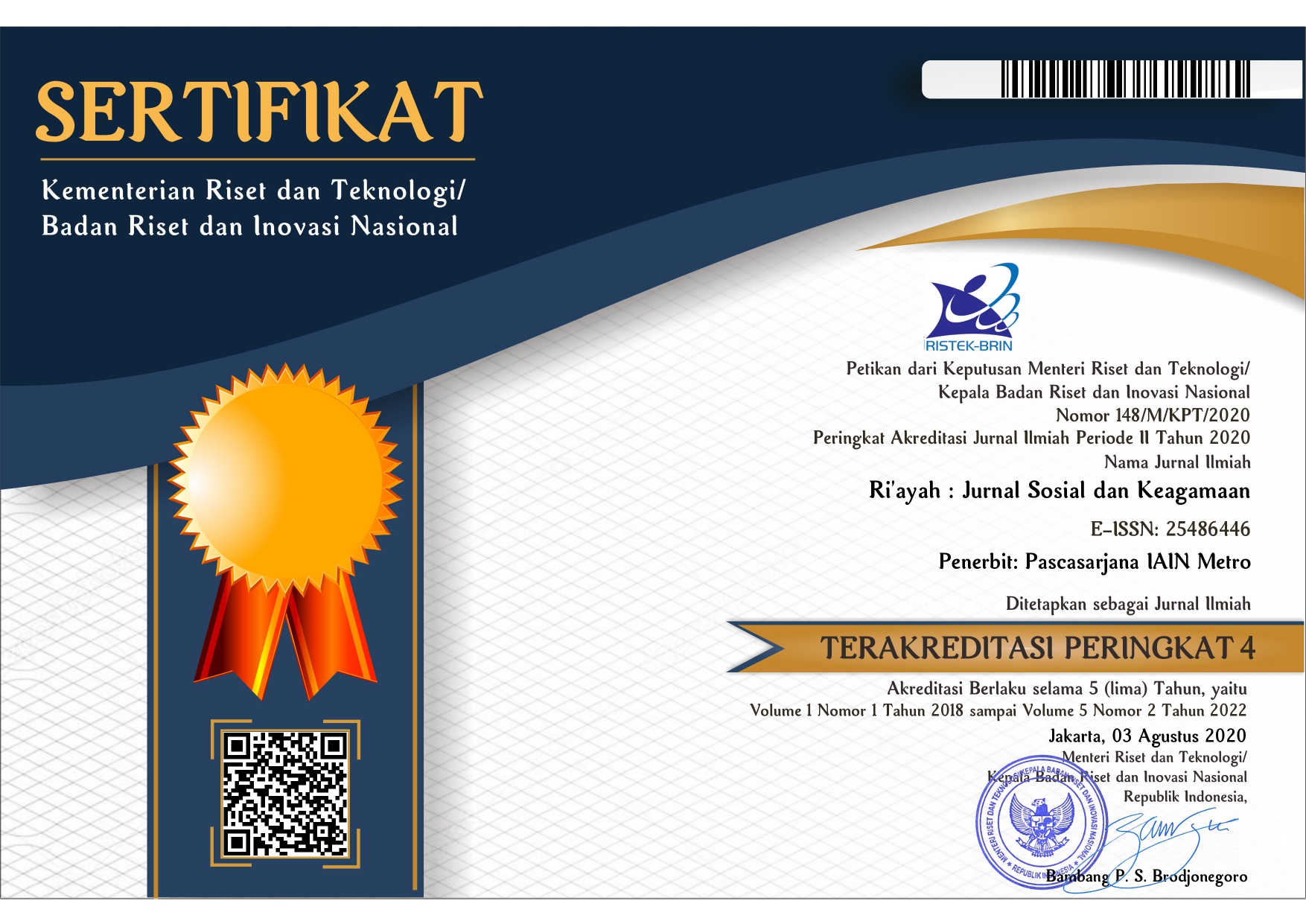SYI'IR TANPO WATON RECONSTRUCTION OF LOCAL CULTURE IN THE CONTEXT OF TASAWUF
Abstract
Syi'iran is a form of local Javanese tradition or tradition which is converted into Islamic teachings. The chanting voices of the santri reading and singing poetry and other syi'ir became the menu in the morning, afternoon, evening and night in various pesantren. Several subjects in pesantren, especially language and literature in pesantren, contribute to the existence of the image of Islam today and tomorrow. It is a "soft thread" that determines "the motifs and patterns of Islamic weaving" which are full of nuances of beauty and wisdom. Syi'iran has become a mandatory menu to support their learning in pesantren. In the learning process, the students are not too far from the Arabic syi'ir, they must learn and understand the santri as the basic foundation in the grammatical study of Arabic, which is full of literary values that echoes to the corners of the pesantren.
The Syi'ir Tanpo Waton research on the reconstruction of local Islamic culture in the context of Sufism is a research that uses field research methods with qualitative descriptive research types, by applying research concepts that are in accordance with conditions in the field. Qualitative research method, Creswell quoted by JR Raco defines it as an approach or search to explore and understand a central phenomenon. Qualitative methods treat participants as subjects and not objects. This is where the participants find themselves as valuable, because the information is very useful. This research method provides a very large space for participants. The pesantren community as mothers who give birth may think that a child born named syi'ir written in Javanese is too small to be appreciated, especially when compared to the literary treasures of books written in Arabic by priests of madhhab and great scholars from Arabia. . This could be due to ignorance or negligence of the pesantren community in appreciating its literary tradition because it is more concerned with the scientific tradition. The meanings contained in the text of syi'ir tanpo waton provide a lot of understanding and influence on the personal life of humans or society. This syi'ir describes the principle of human interaction, namely, “hablu mina Allah and hablu minan nas”, namely the relationship between humans and God and the relationship between humans and humans. This could be due to ignorance or negligence of the pesantren community in appreciating its literary tradition because it is more concerned with the scientific tradition. The meanings contained in the text of syi'ir tanpo waton provide a lot of understanding and influence on the personal life of humans or society. This syi'ir describes the principle of human interaction, namely, “hablu mina Allah and hablu minan nas”, namely the relationship between humans and God and the relationship between humans and humans. This could be due to ignorance or negligence of the pesantren community in appreciating its literary tradition because it is more concerned with the scientific tradition. The meanings contained in the text of syi'ir tanpo waton provide a lot of understanding and influence on the personal life of humans or society. This syi'ir describes the principle of human interaction, namely, “hablu mina Allah and hablu minan nas”, namely the relationship between humans and God and the relationship between humans and humans.
The preservation of syi'iran culture is the original derivative culture of the pesantren. In this case, the preservation of syi'iran in the pesantren is carried out in a recitation program which then asks the congregation to memorize it. The next stage, the kiai will explain in detail the purposes contained in the singiran, with the hope that the congregation will know and be able to practice it in their lives. To always remember the singiran and can be heard by many people, it is advisable to chant the singiran at the time between the call to prayer and iqamah in the mosque. In addition, it can also avoid conversing or playing in the mosque while waiting for the imam to perform congregational prayers.
Downloads
References
Al-Ataftazani, Abu al-Wafa' al-Ghanimi. Sufis from Age to Age. trans. Ahmad Rofi' 'Ottoman. (Bandung: Library Publisher 1997)
Al-Ataftazani, Abu al-Wafa' al-Ghanimi Sufi from Age to Age. Trans. Ahmad Rofi' 'Ottoman. (Bandung: Library Publisher 1997)
Arif Budiono, Interpretation of the Al-Quran through Semiotics and Anthropology (A Study of Muhammad Arkoun's Thoughts), Miyah Vol. XI No. 02 August 2015
Henry Guntur Tarigan, Basic Principles of Literature, (Bandung: Angkasa, 1984)
Irawan Suhartono, Social Research Methods (Bandung: Rosdakarya Youth, 2000),
Isa A. The essence of Sufism, (Bandung: Hidayah Library 2008)
JR Raco, Qualitative Research Methods, Types, Characteristics and Advantages, (Jakarta: Gramedia 2010) Creswell, J. Educational Research. Planning, implementing, and evaluating quantitative and qualitative research trans. (Pearson: Prentice Hall 2008).
Krippendorff, Klaus, Content Analysis: An Introduction to Its Methodology, trans. Content Analysis: an introduction to its Methodology, (SAGE Publications, 1991)
Moh. Muzakka Mussaif, Position and Function of Singir as Coastal Javanese Literature Study of NUSA Sociology and Genre, Vol. 13 No. November 4, 2018
Sasangka, Sry Satriya Tjatur Vishnu. Upload Upload Javanese Language (Jakarta: Paramalingua Foundation. 2009)
Sudarwan Danim, Become a Qualitative Researcher, (Bandung: Pustaka Setia 2002),
Syahruddin YS, Literature, Imagination and Religious Empiricism in Indonesian Literary Mosaic, Literary Dimensions from Various Perspectives, (Bandung: Nuansa 2005)
W. Prasetyawan, Reality and Imagination in Religious Literary Works in Indonesian Literary Mosaic, Literary Dimensions from Various Perspectives, (Bandung: Nuansa, 2005)











